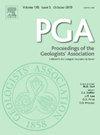南威尔士上三叠世的古土壤
IF 1.2
4区 地球科学
Q2 Earth and Planetary Sciences
引用次数: 0
摘要
南威尔士布里真德附近的临时暴露记录了上三叠统-下侏罗统的过渡,这为评估这一主要地层间隔如何在靠近英国西南部被深入研究的海相和边缘海相演代的陆相沉积物中表现出来提供了难得的机会。随着岸线砂体的沉积和暴露,在随后的间断海侵中形成了高达8 米的海岸平原沉积物。这些矿床拥有一系列古土壤,具有不寻常的碳酸盐结构,复杂的斑驳风格和显著的横向变异性,并有水文条件变化的证据。最初,含钙质的土壤覆盖在海岸线的砂岩上,但被含碳酸亚铁的黏土覆盖,这可能标志着海水的影响。随后,发生了向排水良好的钙质层土壤的过渡。持续的泥级沉积的标志是伪泥质条件的发展,最终在泥质土壤中达到顶峰,上面覆盖着海洋沉积物。这提供了一个例子,说明在沉积体系中遇到的古土壤往往具有复杂的多阶段和多成因性质。本文章由计算机程序翻译,如有差异,请以英文原文为准。
Palaeosols from the Upper Triassic of South Wales
Temporary exposures recording the Upper Triassic–Lower Jurassic transition near Bridgend, South Wales provided a rare opportunity to assess how this major stratigraphical interval is manifested in terrestrial deposits in close proximity to the intensively studied marine and marginal marine successions in SW Britain. Following the progradation and exposure of a shoreline sandbody, up to 8 m of coastal plain deposits formed during a subsequent punctuated transgression. These deposits host a series of palaeosols with unusual carbonate textures, complex mottling styles and marked lateral variability, with evidence of several changes in hydrological conditions. Initially calcrete-bearing soils capped the shoreline sandstones but were overprinted by ferroan-carbonate-bearing gleys likely marking the influence of marine waters. Subsequently, a transition to well-drained soils with calcrete horizons occurred. Continued mud grade deposition was marked by the development of pseudo-gley conditions culminating in gleyed soils, overlain by marine sediments. This provides an example of the often complex polyphase and polygenetic nature of palaeosols encountered in aggrading sedimentary systems.
求助全文
通过发布文献求助,成功后即可免费获取论文全文。
去求助
来源期刊
CiteScore
2.70
自引率
8.30%
发文量
54
审稿时长
6-12 weeks
期刊介绍:
The Proceedings of the Geologists'' Association is an international geoscience journal that was founded in 1859 and publishes research and review papers on all aspects of Earth Science. In particular, papers will focus on the geology of northwestern Europe and the Mediterranean, including both the onshore and offshore record. Following a long tradition, the PGA will focus on: i) a range of article types (see below) on topics of wide relevance to Earth Sciences ii) papers on aspects of Earth Science that have societal relevance including geoconservation and Earth management, iii) papers on palaeoenvironments and palaeontology of the Mesozoic and Cenozoic, iv) papers on aspects of Quaternary geology and climate change, and v) papers on the history of geology with particular reference to individuals that have shaped the subject. These topics will also steer the content of the themes of the Special Issues that are published in the PGA.

 求助内容:
求助内容: 应助结果提醒方式:
应助结果提醒方式:


